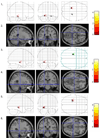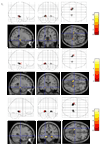Perimenopausal use of hormone therapy is associated with enhanced memory and hippocampal function later in life
- PMID: 21078303
- PMCID: PMC3046212
- DOI: 10.1016/j.brainres.2010.11.030
Perimenopausal use of hormone therapy is associated with enhanced memory and hippocampal function later in life
Abstract
Evidence suggests that initiation of some forms of hormone therapy (HT) early in the perimenopausal or postmenopausal stage might confer benefit to verbal memory and the neural systems underlying memory, whereas late-life initiation confers no benefit or harm. This "critical window hypothesis" remains a topic of debate. Using functional magnetic resonance imaging (fMRI), we examined the long-term impact of perimenopausal HT use on brain function during performance of verbal and figural memory tasks. Participants were 34 postmenopausal women (mean age 60 years) from the Melbourne Women's Midlife Health Project and included 17 early (perimenopausal) and continuous users of HT and 17 never users matched on age, education, and verbal knowledge. Continuous HT use from the perimenopausal stage versus no use was validated with prospective daily diary records and study visit data. The primary outcome was patterns of brain activation in an a priori region of interest in the medial temporal lobe during verbal encoding and recognition of words. Results indicated that perimenopausal HT users performed better than nonusers on the imaging verbal memory task (p<.05). During verbal recognition, perimenopausal HT users showed increased activation in the left hippocampus and decreased activation in the parahippocampal gyrus bilaterally compared with never users. Each of these patterns of activation was associated with better memory performance on the imaging memory task. These results suggest that perimenopausal use of HT might confer long-term benefits to verbal memory and the brain systems underlying verbal memory. More generally, the results support the critical window hypothesis.
Copyright © 2010 Elsevier B.V. All rights reserved.
Figures


Similar articles
-
Perimenopausal symptoms, quality of life, and health behaviors in users and nonusers of hormone therapy.J Am Acad Nurse Pract. 2007 Nov;19(11):602-13. doi: 10.1111/j.1745-7599.2007.00260.x. J Am Acad Nurse Pract. 2007. PMID: 17970860
-
Sex and post-menopause hormone therapy effects on hippocampal volume and verbal memory.Neuropsychol Dev Cogn B Aging Neuropsychol Cogn. 2017 May;24(3):227-246. doi: 10.1080/13825585.2016.1182962. Epub 2016 Jun 4. Neuropsychol Dev Cogn B Aging Neuropsychol Cogn. 2017. PMID: 27263667 Free PMC article.
-
The association of serum oestradiol level, age, and education with cognitive performance in peri- and late postmenopausal women.Maturitas. 2012 Feb;71(2):173-9. doi: 10.1016/j.maturitas.2011.11.025. Epub 2011 Dec 23. Maturitas. 2012. PMID: 22197594
-
[Hormone replacement therapy in peri- and postmenopause].Internist (Berl). 2020 Jun;61(6):558-564. doi: 10.1007/s00108-020-00789-x. Internist (Berl). 2020. PMID: 32333087 Review. German.
-
Effects of hormone replacement therapy on cognitive and brain aging.Ann N Y Acad Sci. 2001 Dec;949:203-14. doi: 10.1111/j.1749-6632.2001.tb04023.x. Ann N Y Acad Sci. 2001. PMID: 11795355 Review.
Cited by
-
Sex Hormones, Sleep, and Memory: Interrelationships Across the Adult Female Lifespan.Front Aging Neurosci. 2022 Jul 14;14:800278. doi: 10.3389/fnagi.2022.800278. eCollection 2022. Front Aging Neurosci. 2022. PMID: 35912083 Free PMC article. Review.
-
Ovarian steroid hormones: A long overlooked but critical contributor to brain aging and Alzheimer's disease.Front Aging Neurosci. 2022 Jul 19;14:948219. doi: 10.3389/fnagi.2022.948219. eCollection 2022. Front Aging Neurosci. 2022. PMID: 35928995 Free PMC article. Review.
-
Association between menopausal hormone therapy and risk of neurodegenerative diseases: Implications for precision hormone therapy.Alzheimers Dement (N Y). 2021 May 13;7(1):e12174. doi: 10.1002/trc2.12174. eCollection 2021. Alzheimers Dement (N Y). 2021. PMID: 34027024 Free PMC article.
-
Cognitive complaints after breast cancer treatments: examining the relationship with neuropsychological test performance.J Natl Cancer Inst. 2013 Jun 5;105(11):791-801. doi: 10.1093/jnci/djt073. Epub 2013 Apr 19. J Natl Cancer Inst. 2013. PMID: 23606729 Free PMC article.
-
A long-term cyclic plus tonic regimen of 17β-estradiol improves the ability to handle a high spatial working memory load in ovariectomized middle-aged female rats.Horm Behav. 2020 Feb;118:104656. doi: 10.1016/j.yhbeh.2019.104656. Epub 2019 Dec 23. Horm Behav. 2020. PMID: 31862208 Free PMC article.
References
-
- Andresen EM, et al. Screening for depression in well older adults: evaluation of a short form of the CES-D (Center for Epidemiologic Studies Depression Scale) Am J Prev Med. 1994;10:77–84. - PubMed
-
- Brett K, Chong Y. National Center for Health Statistics. Maryland: Hyattsville; 2001. Hormone Replacement Therapy: Knowledge and Use in the United States.
-
- Cabeza R, Nyberg L. Imaging cognition II: An empirical review of 275 PET and fMRI studies. J Cogn Neurosci. 2000;12:1–47. - PubMed
-
- Clark MS, et al. Normative verbal and non-verbal memory test scores for Australian women aged 56–67. Aust N Z J Psychiatry. 2004;38:532–540. - PubMed
Publication types
MeSH terms
Grants and funding
LinkOut - more resources
Full Text Sources
Medical

